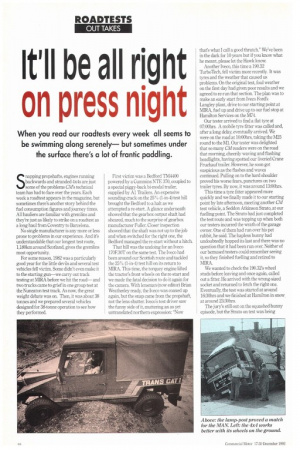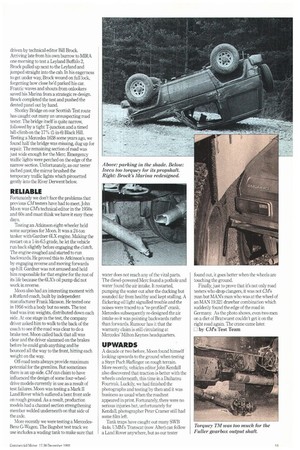It'll be all right on press night
Page 54

Page 55

If you've noticed an error in this article please click here to report it so we can fix it.
When you read our roadtests every week all seems to be swimming along serenely— but sometimes under the surface there's a lot of frantic paddling.
Snapping propshafts, engines running backwards and stranded 4x4s are just some of the problems CMs technical team has had to face over the years. Each week a roadtest appears in the magazine, but sometimes there's another story behind the fuel consumption figures and journey times. All hauliers are familiar with gremlins and they're just as likely to strike on a roadtest as a long haul from Coventry to Barcelona.
No single manufacturer is any more or less prone to problems in our experience. And it's understandable that our longest test route, 1,180km around Scotland, gives the gremlins most opportunity.
For some reason, 1982 was a particularly good year for the little devils and several test vehicles fell victim. Some didn't even make it to the starting gun—we carry out track testing at MIRA before we hit the road— and two trucks came to grief in one group test at the Nuneaton test track. As now, the great weight debate was on. Then, it was about 38 tonnes and we prepared several vehicles designed for 38-tonne operation to see how they performed.
First victim was a Bedford T1144400 powered by a Cummins NTE 370, coupled to a special piggy-back bi-modal trailer, supplied by Al Trailers. An expensive sounding crack on the 25% (1-in-4) test hill brought the Bedford to a halt as we attempted a re-start. A glance underneath showed that the gearbox output shaft had sheared, much to the surprise of gearbox manufacturer Fuller. Closer inspection showed that the shaft was not up to the job and when switched for the right one, the Bedford managed the re-start without a hitch.
That hill was the undoing for an Iveco 170E30T on the same test. The Iveco had been around our Scottish route and tackled the 25% (1-in-4) test hill on its return to MIRA. This time, the torquey engine lifted the tractor's front wheels on the re-start and we made the fatal decision to do it again for the camera. With lensman (now editor) Brian Weatherley ready, the Iveco was coaxed up again, but the snap came from the propshaft, not the lens shutter. Iveco's test driver saw the funny side of it, muttering an as yet untranslated northern expression: "Now that's what I call a good thrutch." We've been in the dark for 10 years but if you know what he meant, please let the Hawk know.
Another Iveco, this time a 190.32 TurboTech, fell victim more recently. It was tyres and the weather that caused us problems. On the original test, foul weather on the first day had given poor results and we agreed to re-run that section. The plan was to make an early start from Iveco Ford's Langley plant, drive to our starting point at MIRA, fuel up and drive up to our fuel stop at Hamilton Services on the M74.
Our tester arrived to find a flat tyre at 07:00hrs. A mobile tyre fitter was called and, after a long delay, eventually arrived. We were on the road at 10:00hrs, taking the M25 round to the Ml. Our tester was delighted that so many CM readers were on the road that morning, cheerily waving and flashing headlights, having spotted our liveried Crane Fruehauf trailer. However, he soon got suspicious as the flashes and waves continued. Pulling on to the hard shoulder proved his worse fears, punctures on two trailer tyres. By now, it was around 13:00hrs.
This time a tyre fitter appeared more quickly and we finally made it to our starting point by late afternoon, meeting another CM test vehicle, a Seddon Atkinson Strato, at our fuelling point. The Strato had just completed the test route and was topping up when both our testers incurred the wrath of the garage owner. One of them had run over his pet rabbit, he said. The hapless bunny had undoubtedly hopped its last and there was no question that it had been run over. Neither of our bemused testers could remember seeing it, so they finished fuelling and retired to MIRA.
We wanted to check the 190.32's wheel studs before leaving and once again, called out a fitter. He arrived with the wrong-sized socket and returned to fetch the right one. Eventually, the test was started at around 16:30hrs and we finished at Hamilton in snow at around 23:30hrs.
The jury's still out on the squashed bunny episode, but the Strato on test was being driven by technical editor Bill Brock. Arriving late from his own burrow to MIRA one morning to test a Leyland Buffalo 2, Brock pulled up next to the Leyland and jumped straight into the cab. In his eagerness to get under way, Brock wound on full lock, forgetting how close he'd parked his car. Frantic waves and shouts from onlookers saved his Marina from a strategic re-design. Brock completed the test and pushed the dented panel out by hand.
Shotley Bridge on our Scottish Test route has caught out many an unsuspecting road tester. The bridge itself is quite narrow, followed by a tight T-junction and a timed hill-climb on the 17% (1-in-6) Black Hill. Testing a Mercedes 1638 some years ago, we found half the bridge was missing, dug up for repair. The remaining section of road was just wide enough for the Merc. Emergency traffic lights were perched on the edge of the narrow section. Unfortunately, as our tester inched past, the mirror brushed the temporary traffic lights which pirouetted gently into the River Derwent below.
RELIABLE
Fortunately we don't face the problems that previous CM testers have had to meet. John Moon was CAA technical editor in the 1950s and 60s and must think we have it easy these days.
Testing an Atkinson eight-wheeler held some surprises for Moon. It was a 24-ton tanker with Gardner 6LX engine. Making the restart on a 1-in-6.5 grade, he let the vehicle run back slightly before engaging the clutch. The engine coughed and started to run backwards. He proved this to Atkinson's men by engaging reverse and moving forwards up-hill. Gardner was not amused and held him responsible for that engine for the rest of its life because the 6LX's oil pump did not work in reverse.
Moon also had an interesting moment with a Rutland coach, built by independent manufacturer Frank Manson. He tested one in 1956 with a body but no seats. The test load was iron weights, distributed down each side. At one stage in the test, the company driver asked him to walk to the back of the coach to see if the road was clear to do a brake test. Moon called back that all was clear and the driver slammed on the brakes before he could grab anything and he bounced all the way to the front, hitting each weight on the way.
Off-road tests always provide maximum potential for the gremlins. But sometimes there is an up-side. CM can claim to have influenced the design of some four-wheeldrive models currently in use as a result of test failures. Moon was testing a Mark II Land Rover which suffered a bent front axle on rough ground. As a result, production models had a channel section strengthening member welded underneath on that side of the axle.
More recently we were testing a MercedesBenz G-Wagen. The Bagshot test track we use includes a wading tank to make sure that water does not reach any of the vital parts. The diesel-powered Mery found a pothole and water found the air intake. It restarted, pumping the water out after the ducking but sounded far from healthy and kept stalling. A flickering oil light signalled trouble and the noises were traced to a "re-profiled" crank, Mercedes subsequently re-designed the air intake so it was pointing backwards rather than forwards, Rumour has it that the warranty claim is still circulating at Mercedes' Milton Keynes headquarters.
UPWARDS
A decade or two before, Moon found himself looking upwards to the ground when resting a Steyr Puch Haflinger on rough terrain. More recently, vehicles editor John Kendall also discovered that traction is better with the wheels underneath, this time in a Daihatsu Fourtrak. Luckily, we had finished the photographs and testing by then and it was business as usual when the roadtest appeared in print. Fortunately, there were no serious injuries but, unfortunately for Kendall, photographer Peter Cramer still had some film left.
Tank traps have caught out many SWB 4x4s. UNIM's Transcat (now Alter) can follow a Land Rover anywhere, but as our tester found out, it goes better when the wheels are touching the ground.
Finally, just to prove that it's not only road testers who drop dangers, it was not CMs man but MAN'S man who was at the wheel of an MAN 19.321 drawbar combination which suddenly found the edge of the road in Germany As the photo shows, even two men on a diet of Bratwurst couldn't get it on the right road again. The crane came later. LI by Cilfs Test Team
























































































